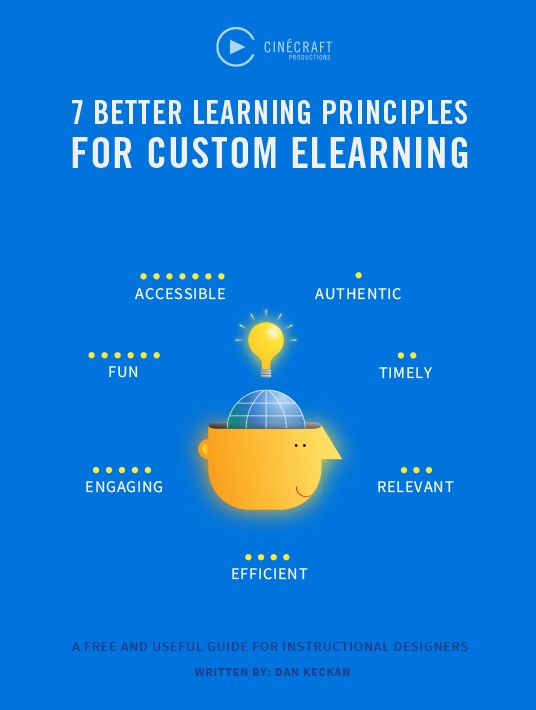Business Impact Is Possible With Relevant Content
Marcus is creating a custom eLearning course on a new sales order system, for inside sales representatives who process incoming orders.
Julia: "Let's include as much as possible."
Marcus: "On second thought, I think we should narrow it down to exactly what we need."
The project’s primary stakeholder and Subject Matter Expert (SME), Julia, is very engaged and enthusiastic about the training—that’s the good news. The challenge is that Julia wants the course to include a narrative of the history of the system, detailed descriptions of all the reports that managers can run, and a schematic of how the sales order system integrates with the company’s other enterprise software. Should Marcus do what Julia wants? If not, why not?
What learners need—and what Marcus needs to put in his course—is content that is Relevant.

Relevance, Goals, And Objectives—Oh My!
Marcus started to gather as much information as he could at the start of this project. He interviewed Julia, observed inside sales representatives, and discussed the features of the new system with IT so that he could design an Authentic custom eLearning course. Marcus had so much—maybe even too much—information! How should he figure out if certain content is Relevant?
Marcus needs to start with the business goal: Increase productivity and decrease data entry errors in the new sales order system.
Then, write the learning objectives:
- Access and navigate the sales order system
- Create and modify sales order records
Anything that doesn’t directly support both of these should not have any screen time in his course. Will a history of the system help learners to achieve these objectives? Unlikely. Nor will database schematics or reports that only managers can run. Marcus needs to ask himself, “If this particular piece of information isn’t in the course, will it impact learners’ job performance? Is it really Relevant, just nice-to-know, or something that no one will really care about?” He needs to ask Julia, “Do you need this history of the sales order system, or do you want to keep this history of the sales order system?” If she needs it then, by golly, keep it in there. But, if Julia wants it because it makes her feel more complete then kindly ask her to throw it in the trash. Sometimes there are topics that seem interesting or even essential to project stakeholders, like Julia, but they don’t actually help learners perform on the job. And, if Marcus is unsure about a topic, he should ask an inside sales representative who is successful in the role.
The More They Know, The Less You Have To Tell Them
At the start of the project, Julia told Marcus that she wants to train to the “lowest common denominator,” (i.e. a new hire in the inside sales department). However, Marcus knows that this group typically has low turnover, so only about 10% of the group is new. If turnover is low, why base the training only on new hires? Marcus and Julia should consider the majority of the audience’s prior knowledge. If they’re concerned about training new hires with little experience, they could provide a separate onboarding course or video that provides the learners with an “understanding” of how the sales order system supports them in their role. I won’t get into a detailed discussion of Bloom’s Taxonomy Verbs, but we all know that “understand” is not on the list, due to the fact it lacks an actionable, measurable or specific outcome. Experienced inside sales representatives will have this context already—and will have worked in the sales order system before. Marcus should do an analysis of the previous system’s configuration vs. the new system to see how much the processes and procedures differ. If the processes are similar in the new system, learners may be able to perform the tasks with the help of a job aid. If not, they may just need quick screenshot tutorials for performance support. But, Marcus must not forget about the 10%. Marcus can serve these new recruits as well by designing scenarios that can either be practiced in an eLearning simulation or even in the sales order system’s test environment with the help of a supervisor.
Whatever Julia Wants, Julia Gets, Right?
What if Marcus does an audience analysis, gathers content, and makes a recommendation that’s tied to the business goals and learning objectives, only to be vetoed by Julia? She still feels strongly that all learners need to know the system history and how to run reports. Julia is the system owner, after all. Maybe there’s a compromise? Marcus should have a discussion with her about the minimum information needed for learners to perform their regular tasks in the sales order system. He can offer to include information that is needed on occasion or in special circumstances in a job aid or other quick reference resource. This way, the learners are only required to take the Relevant content, and everything that’s “nice-to-know” is readily available.
Creating A Relevant Custom eLearning Solution Really Boils Down To 3 Tasks:
- Identify the business goal.
- Write learning objectives to support this goal.
- Analyze your content and narrow it down based on what the learners actually need to be able to do on-the-job.
Relevant content offers more benefits than just motivating your learners—it provides a training experience that targets measurable results and doesn’t waste the learners’ time with unnecessary information. L&D managers can impact learners with relevant custom eLearning solutions, but it would be great if they download our eBook 7 Better Learning Principles For Custom eLearning" to truly optimize their processes. You can also watch the supporting webinar "Maximize Learning Effectiveness Using The 7 Better Learning Principles" and unlock the full potential of performance-based learning.


